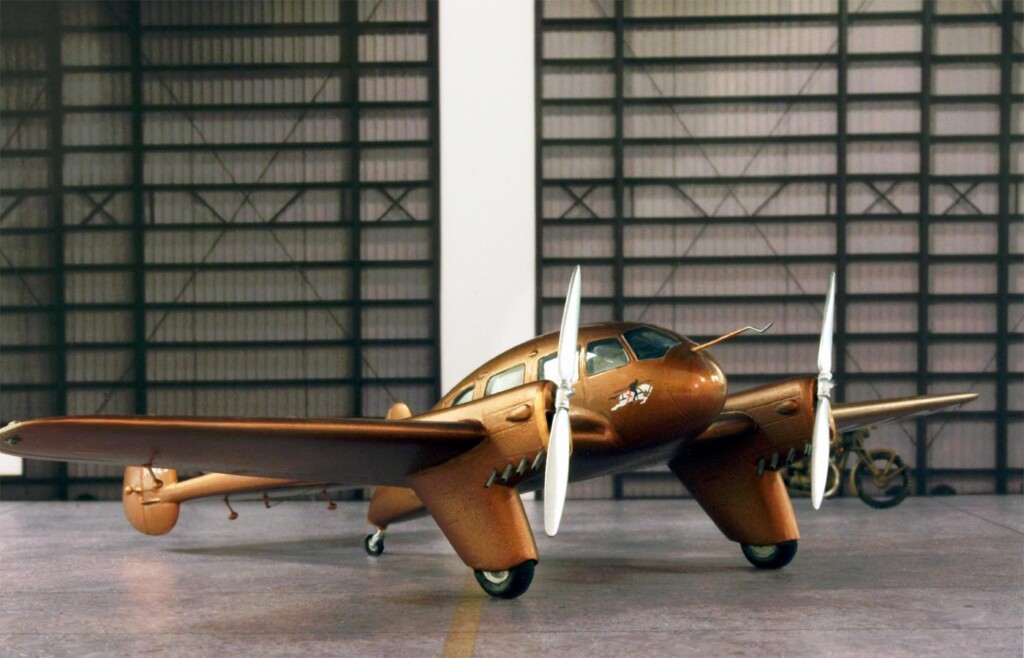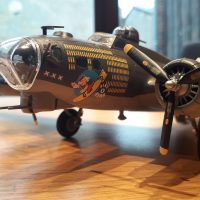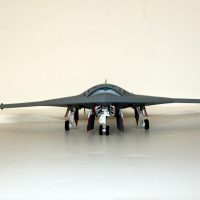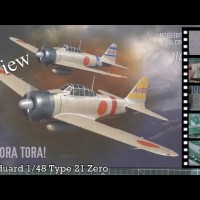A small shiny metallic beetle – and the only one of its kind! American Gyro AG-4 Crusader
To the American Gyro AG-4 Crusader
Two tail units terminated by disc-shaped rudders and aerodynamically cleanly blended into the fairings of two in-line engines towards the nose, with a teardrop-shaped nacelle for the crew in their centre: hasn't this design been seen before - as the P-38 Lightning? The sight of the AG-4 Crusader evokes interesting analogies, and perhaps not without reason, as will be read below at the end of an exciting story.
Beyond this analogy, the sight of the Crusader evokes another association: modernity! If one considers the date of the first flight, one may be astonished by this ambitious collection of innovative elements. In April 1935, the elegant all-metal aircraft took off on its maiden flight. This had been preceded by months of intensive planning by aeronautical engineer Thomas Miles Shelton, who had been commissioned a good year earlier by Edgar R. Holmes, General Manager of the American Gyro Company, to develop a four-seater business and sports aircraft.
The American Gyro Company had nothing to do with the development of aeroplanes itself, but produced accessory parts such as spark plugs for General Motors. Perhaps it was a stroke of luck that the young engineer Thomas M. Shelton was able to go to work unencumbered by the traditions and possibly overly rigid views of an established aircraft manufacturer: with the conception of the AG-4 Crusader, he demonstrated not only courage, but also foresight.
From the underlying layout to the details, the "Crusader" design made use of the most modern technology: the airframe and wings were designed as self-supporting half-shells covered with aluminium, whereby the metal cladding also had a load-bearing function. The metal used for this consisted of the special alloy 17 ST, which was applied with countersunk rivets. Remarkably, the rudder surfaces were also covered with metal, a feature that was not to become established for high-performance aircraft until the mid-1940s. The wheels of the main landing gear were pneumatically braked, the tail wheel mounted at the rear of the nacelle could be steered by cable. Incidentally, after the maiden flight, the single AG-4 built was converted to a retractable landing gear, another innovation that could have had a positive effect on its flight performance.
Has this trust in promising but largely unproven techniques and technology paid off? An answer to this question can be found in the flight performance - and this speaks for itself! The top speed of 375 km/h measured at an altitude of 2000 metres made the AG-4 a real "hot potato"; in any case, it was by far faster than all the fighter planes of the USAAC at the time and thus one of the fastest US aircraft of its time. It owed its speed and agility to its weight-saving all-metal half-shell construction, a technique that was also used at about the same time by "lightweight pope" Willy Messerschmitt on the Bf 109, which flew for the first time in Germany in the same year. The Crusader reached the summit altitude of 5,500 metres in 20 minutes, the contents of the tanks, 189 litres, provided enough fuel for 3 hours of flight time, which meant a range of a good 900 kilometres, the whole with a maximum payload of 450 kg. In summary, one can say that it was not bad for a sports aircraft in 1934!
With such brilliant performances, the question arises as to why only one AG-4 Crusader was built. It can't have been due to a lack of attention from the aviation world, as greats such as William Randolph Hearst jr, Howard Hughes and Emilia Earhart took an interested look at the sleek four-seater. The aircraft was also demonstrably inspected by Lockheed technicians. If one is to believe the numerous stories that soon grew up around the AG-4 Crusader, the aircraft was also thoroughly measured by the Lockheed people on these occasions. This provides the announced reference to the optical similarity with the Lockheed P-38 Lightning mentioned at the beginning: the proximity of the two constructions, following this story, would not only be superficial and not coincidental, but a sign of technological kinship. A further colour is given to this dazzling story by the failed patent application of the engineer Thomas M. Sheltons for the concept realised on the Crusader of a twin-engine design with two tail booms and a central teardrop-shaped canopy.
Lockheed's lawyers, like those of Hughes Aircraft Corporation, objected to the patenting and Shelton's application was indeed rejected. The US government, which had also lobbied against the issuance of a patent in the name of national security, also had an influence.
The American Gyro Company founded a subsidiary, the Crusader Aircraft Corporation, to market the AG-4 Crusader. However, its activities remained unsuccessful. In 1936, a first attempt to save the company failed: the design documents of the AG-4 and those of an enlarged seven-seat version were to be sold to the Timm Aircraft Company, but this deal also fell through. By 1938, the end of the line had finally been reached: the Crusader Aircraft Corporation was bankrupt and had to file for bankruptcy.
Even though the venture of an ambitious business aircraft was ultimately a failure, the AG-4 Crusader left its mark on the history of aviation. For Thomas Miles Shelton, a successful life as an aeronautical engineer continued; in later years he was still involved in the development of the SR-71 Blackbird. He must have made his peace with Lockheed by then!
About the kit and the building process
One of the best qualities of the Avia kit is: its very existence! Who could have predicted that there would ever be a polysterol kit of such an exotic aircraft? Apart from that, the plastic parts also delight with another essential quality: their basic usability!
Of course, there is a lot of preparation, extra work and improvisation involved in building such a short-run kit. Here I am thinking especially of the many fitting tests, where individual parts had to be worked on heavily in order to achieve a usable fit. This applies especially to the tail booms and the engine nacelles.
With regard to the tail booms, a serious difficulty must be pointed out, which, if not taken into account, can endanger the entire construction: please check the angle at which the two fuselage booms are mounted to the wings in relation to the longitudinal axis of the aircraft! If this angle is too shallow, the tail wheel mounted at the end of the nacelle will no longer reach the ground and the aircraft would rest on the two tail fins. The building plan does not give any hints about this danger and also the fit of the parts does not give any binding instructions. So think and glue very carefully!
As an improvement, I replaced the exhaust pipes with hollow brass pipes and sharpened the propeller blades and propeller spinners, which were also too soft. The two two-blade props were then drilled to sit on a metal wire. This arrangement allowed me to paint the props comfortably and the wire pins also improved the fit of the props on the finished model.
A solid prototype research pays off especially with the AG-4 Crusader, as the building instructions simply omit some important details. This refers especially to the rudder balance weights, which are included as (completely useless) kit parts for the ailerons, but are also found on all other control surfaces. So these have to be improvised. I did this using "aerodynamic flat wire" from the biplane bracing area and a drop of white glue. If you pull the drop of white glue applied with a toothpick to one end of the wire backwards and repeat the process often enough to achieve a useful result, with a little luck and experience you will get a useful aerodynamic shape for the weight.
Improvisation is also required for the prominent pitot tube at the upper nose of the nacelle, as well as for the representation of the elevator control wires, which are led out of the upper nacelle tail to the two rudder horns (which have also been scratched from flat "aero" wire).
I was looking forward to the painting of the AG-4 Crusader the whole time I was building it: "Bronze" from Alclad was used for this, which was surprisingly comfortable and easy to do. To achieve the gloss burr that seemed right to me, several layers of glossy and glossy/matt clear varnish from Gunze were applied to the surfaces.
As you can see from the lines above, a little effort went into this little model. But there was one thing that had become immense by the time the project was finished: the joy of an extraordinary project with an interesting history as well as the small, metallic shining highlight in the showcase- in bronze!

































Great presentation and build, Roland. I like the on site airport pics as well. Take the windows away it could fit in with todays many variations of unmanned aircraft/drones. Again...well done!
An incredible story, Roland, and an equally incredible model, I’ve really enjoyed reading this post and admiring your photographs.
Fully agree with the previous "speakers". Love those unique exotic airplanes.
Well, that's something I never knew about before.
Your usual great work has had the usual superb result, @rosachsenhofer.
Well, that's certainly a little different, love it! Excellent build, sounds like it was a challenge. Looks like it had Menasco engines?
This is a very rare and unusual aircraft, Roland @rosachsenhofer
Never heard about this aircraft therefore the excellent article makes it very interesting.
Your build is excellent, great finish and details.
The pictures taken make it look like a real one, especially the hangar and airfield ones.
It's obvious from the construction photos that there were some fit challenges, but the end result is superb– a real gem.
Another wonderful result, Roland! An absolutely rare subject, a perfectly built, painted and presented model! Your accompanying article, is,a s usual, amazing!
Well done!
What an interesting subject and a great result. This model really is a little gem and well worth the effort.
@rosachsenhofer - great article and beautiful build Roland!
Thank you very much for all this great feedback and comments! I am happy about your words, your interest and your "mentions" of course - and I am also a little proud that the text accompanying the pictures is of interest to you and that you like it! I feel motivated, thank you!
@rosachsenhofer: That is the coolest little plane that I’ve never seen before or heard of. That bronze paint job looks outstanding. Bravo Roland.
Thank you Eric! That is really very appreciated!
@rosachsenhofer Ultra cool looking aircraft. Your build and paintwork are outstanding!
That’s really interesting, and very good looking. I’ve never heard of this plane before. Well done, Roland.
Very cool - had never seen or heard of this elegant little aircraft before! Nicely done!
Very nice Roland! I've built this kit too, and for it's tiny size it was a lot of work. But I am glad I did: I love the looks of it.
Yes, it was a very promising little airplane. While I was building mine and looking for references, I was lucky enough to find a copy of this very elaborate book on Ebay: https://www.amazon.com/Crusader-Shelton-Flying-company-creator/dp/0962288608